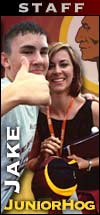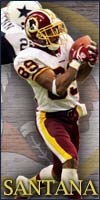The Spurrier Effect
By Thomas Boswell
Sunday, April 25, 2004; Page E01
Now, at last, the Redskins have learned what Steve Spurrier's legacy was: Sean Taylor.
The ex-University of Florida guru may have been a dud as an NFL coach, but he inadvertently got the Redskins a young free safety from the University of Miami who will probably be a Washington star for a decade.
By taking an extremely expensive team with considerable talent and coaching it to a miserable 5-11 record last season, Spurrier accidentally guided the Redskins to the No. 5 overall pick yesterday in a strong NFL draft. With that choice, the Redskins took Taylor, a 231-pound speedster with the kind of ball-hawking skills and soft hands usually associated with a wide receiver. No team with all the gaudy tools owner Daniel Snyder provided Spurrier should ever get such a snazzy pick. But, sometimes, pro football works in mysterious ways.
Despite his two wasted seasons, Spurrier may ultimately be remembered as a Redskins benefactor. If he hadn't been so frustrated by his NFL failures that he quit suddenly, then the Redskins would not have been in position to chase Joe Gibbs at the very moment when he was considering coming out of retirement. Instead, Gibbs might have ended up coaching the Atlanta Falcons, and Michael Vick, next season.
Instead, Gibbs is now beaming over adding Taylor, a somewhat unconventional pick that defensive coordinator Gregg Williams says "speaks volumes about Joe Gibbs and about his team concept."
By the time the Redskins were on the draft clock yesterday, the whole sport knew Washington's choice was between Taylor and his Miami teammate Kellen Winslow Jr., who is not only the son of a Hall of Famer but, in his own right, is a gifted 243-pound tight end. Break tackles? Sure, Winslow can do that, unless he sometimes decides simply to hurdle entirely over defenders.
If Gibbs were a coach driven by ego, sentiment or the desire to make a safe pick, he would have taken Winslow. Many pundits, as well as the majority in an ESPN viewer poll during the draft, predicted that he would. After all, Gibbs coached Winslow's father and created the position of "H-Back" after watching all the damage that the great San Diego Charger wrought. What could be more natural, especially since the Redskins currently have no quality H-Back, than to draft the son of the prototype? Besides, adding another offensive standout would increase the chances that Gibbs would look like a returning genius next season.
Throughout the Snyder era, a Winslow pick would have seemed natural. The Redskins, often influenced by a preference for marketable names, have consistently made personnel decisions that maximized "sizzle." Usually, starting with washed-up Deion Sanders and worthless Jeff George, those choices have proven to lack substance.
By taking Taylor over Winslow, Gibbs signaled a welcome reversal. In evaluating an elite draft pick, he clearly put his stamp on yet another aspect of the Redskins. Gibbs chose a defensive player, even though he runs the offense. Gibbs gave weight to Taylor's ability and willingness to play special teams -- returning kicks or (gasp) blocking kicks. In terms of public persona, Gibbs also picked the player who may be more aligned with his idea of a true Redskin. Taylor is a low-key, floppy-hat fellow who wastes few words and stayed at home with family and friends on draft day. The handsome, elegantly dressed Winslow showed up at Madison Square Garden to bask in his limelight moment as the sixth overall pick taken by Cleveland.
Finally, Gibbs looked for that intangible quality -- the good teammate. Day after day, Clinton Portis, who played at Miami, would whisper in Gibbs's ear, "Sean Taylor, Sean Taylor, Sean Taylor." Gibbs listened.
"Sean is an unusual player . . . with a unique combination of skills. . . . I'm kinda freaky for tight ends. I love tight ends. . . . Kellen was a strong consideration for us. . . . But, in the end, it needed to be Sean," said a delighted Gibbs.
Taylor's first impression on Gibbs was a knockout. "For our workout, I had pictured him thicker, chunkier. I had a vision of him," said Gibbs. "Then I turned around and [actually] saw him. That sucker was tall and cut. He looked like a wide receiver who weighs 205. He was much bigger and taller than I expected."
From films of Miami's national championship game two seasons ago, Gibbs saw the obvious, like "two fabulous [turnover] plays." But he also realized that Taylor was "all over the place. They'd break a play on the other side of the field and he'd start after them. . . . He covers ground like you won't believe."
A bit like Darrell Green, far out of the play, catching Tony Dorsett from behind long ago? Anybody can see the interceptions and forced fumbles on film. Gibbs looks to see which players, 40 yards away from the ball, are flying at full speed on the off chance they might get in a lick.
The final element in Gibbs's decision illustrates the coach's desire to catch up with the evolution of the sport he left 12 years ago.
"The one thing that's most different is that defenses are so much more aggressive now," said Gibbs, becoming so animated as he talked about his beloved X's-and-O's trends that you could see why he just had to come back.
"When I was here [before], sometimes defenses would sit and read. Sometimes, they'd get in the gaps and go hard. Now, they overload the offensive set. If you have seven in the box, they bring up eight [defenders]. Or seven vs. six.
"I remember when Bill Parcells's [Giants] defenses sat back and played that 'umbrella' defense. Now, in Dallas, they're loadin' it up and getting after it," said Gibbs. "Now, everybody blitzes four [defenders] from one side and drops the defensive end back on the other side."
So, what does this have to do with the value of a brilliant free safety? If you're Joe Gibbs, it means everything.
"If your defense is going to be that aggressive, then your cornerbacks are going to have to play a lot of man-to-man defense on the wide receivers. That means you really need a free safety behind them that can cover ground and give them support."
Parcells knows it. In a few months, Gibbs has learned it. Once, Mark Murphy was athletic enough to be a free safety. Not anymore. Not on a championship team. If you're going to attack on defense, then you have to clamp on the wide receivers. That increases danger. So, the last line of a modern NFL defense -- the free safety -- should ideally be manned by a huge, swift, superb athlete who loves to snag interceptions and break quarterbacks' hearts.
"I love when I get an interception and bring it back," said Taylor, who returned three of his 10 interceptions for touchdowns last season. "That's the most excited I can get."
A dozen years ago, the NFL didn't have free safeties like Sean Taylor. Or need them. Now it does.
It didn't take Joe Gibbs long to learn.
http://www.washingtonpost.com/wp-dyn/ar ... r24_2.html

